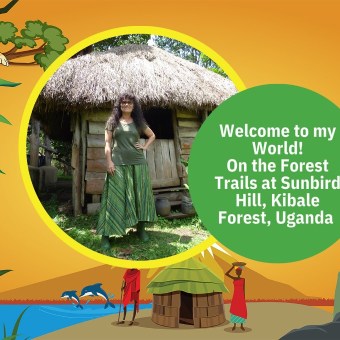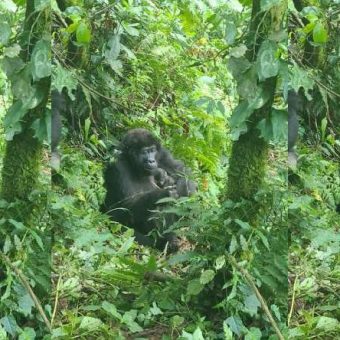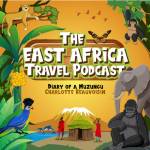What is the conservation status of Mountain Gorillas?
Mountain gorillas (Gorilla beringei beringei) are classified as ‘endangered’ on the IUCN Red List of Endangered Species. It was only in 2018 that they were recategorised from the ‘critically endangered’ listing.

“Today, mountain gorillas are threatened, not due to a demand for their meat, or their infants, but due to a demand for the lush forest in which they live. For the poverty-stricken communities living around the gorilla habitat it is the forest that provides them with many of their basic human needs, and in the war torn areas of Democratic Republic of the Congo these needs are exaggerated.”
Gorilla conservation is the number one conservation priority in Uganda and Rwanda. Gorilla tourism has helped bring the mountain gorilla population back from the brink of extinction but threats to their survival are still very real. The biggest threats to the gorillas come from humans: illegal logging of the rainforest, poaching, encroachment of land for farming and the risk of disease transmission by humans. Additionally, political instability is still a major factor affecting the Congolese population of mountain gorillas in the DRC region of the Virunga Volcanoes.
“Active conservation [of gorillas] involves simply going out into the forest, on foot, day after day after day, attempting to capture poachers, killing—regretfully—poacher dogs, which spread rabies within the park, and cutting down traps.”
The gorilla population numbers in Uganda, Rwanda and the DR Congo have increased from a shockingly low census record of just 254 gorillas in 1981 to an estimated 880 individuals in 2013. In 2018, we were delighted to learn the combined population has just passed the 1,000 mark.
Rangers continue to put their lives on the line every day to protect these gentle giants. Poaching of gorillas is thankfully very rare these days, however they can unwittingly become caught in snares set for other animals.
Rwanda’s annual Kwita Izina gorilla-naming ceremony every September is a fascinating time to visit Volcanoes National Park. It is a celebration of Rwanda’s progress in gorilla conservation, and the challenges these great apes continues to face.
If you trek to see the mountain gorillas, you may be interested to know that a percentage of every gorilla permit fee goes to the communities living around the National Parks. The benefits of this are many: local communities receive a tangible benefit from tourism in remote parts of the country where there are few employment opportunities. This direct financial incentive encourages local people to support tourism. Entry into the national parks is strictly controlled. Before the national parks were gazetted, people entered the forest to collect firewood, burn charcoal, set snares and hunt. The promotion of farming outside the protected areas (vegetable gardens and goat rearing) and the development of alternatives to charcoal (fuel-efficient stoves and solar panels) are just some of the projects that conservation organisations promote in local opportunities.
The removal of the Batwa ‘Pygmies,’ the traditional forest dwellers, from the gorillas’ habitat was another step that the authorities took in the 1990s, when the gorilla population seemed to face certain extinction. The Batwa culture and way of life are unique. By visiting and supporting the Batwa projects (developed as alternative ways of living outside the forest that once supported them) you are directly supporting gorilla conservation.
In recent decades, many people from all over the world have dedicated their lives to the conservation of the mountain gorilla. In 1985, pioneer American primatologist Dian Fossey, was found dead in her home in Volcanoes National Park, believed to have been murdered by one of the poachers she fought in her protection of the gorillas. The mountain gorillas are better protected than ever, and their numbers rising slowly, but each year, rangers from Uganda, Rwanda and the DR Congo put their own lives in danger to protect these marvellous creatures. The ‘Galiwango, Life of a Gorilla’ animated film project pays tribute to the bravery and sacrifice of these rangers.
Which conservation organisations are working to protect the mountain gorillas?
For information on some of the conservation issues and initiatives in and around the national parks of Uganda, Rwanda and the Congo, visit:
Conservation Through Public Health (CTPH)
The Gorilla Organization (TGO) works with communities to protect the habitats of the Mountain Gorillas of Uganda, Rwanda and the Democratic Republic of the Congo.
Uganda Wildlife Authority (UWA) manages the country’s National Parks. UWA rangers are constantly monitoring the whereabouts of Uganda’s gorillas.
Dian Fossey Gorilla Fund International (DFGF)
Blog of the Gorilla Doctors Mountain Gorilla Veterinary Project
International Gorilla Conservation Programme IGCP
Mountain Gorilla Conservation Fund MGCF
Berggorilla & Regenwald Direckthilfe
Gorilla tracking tourism and numerous community tourism initiatives all help raise funds and awareness the plight of the endangered mountain gorillas.
For gorilla tracking stories and Uganda and Rwanda travel advice, click on the hyperlinks in the Ultimate Guide to Mountain Gorilla Tracking. Looking for more info? Check out my Travel Directory or Contact the Muzungu.



























